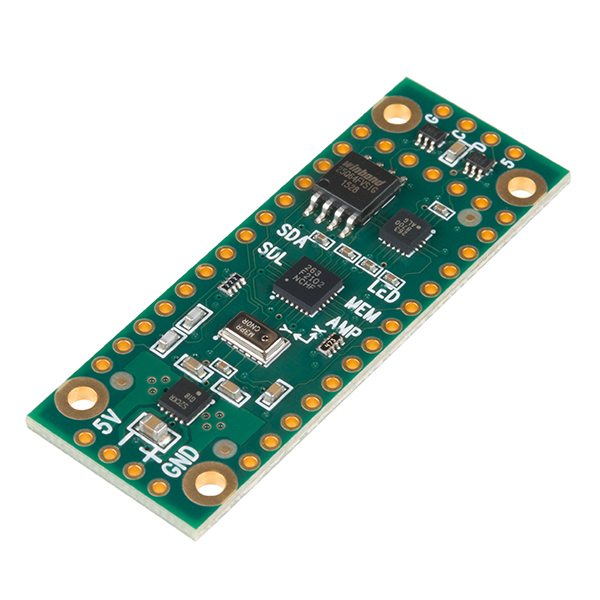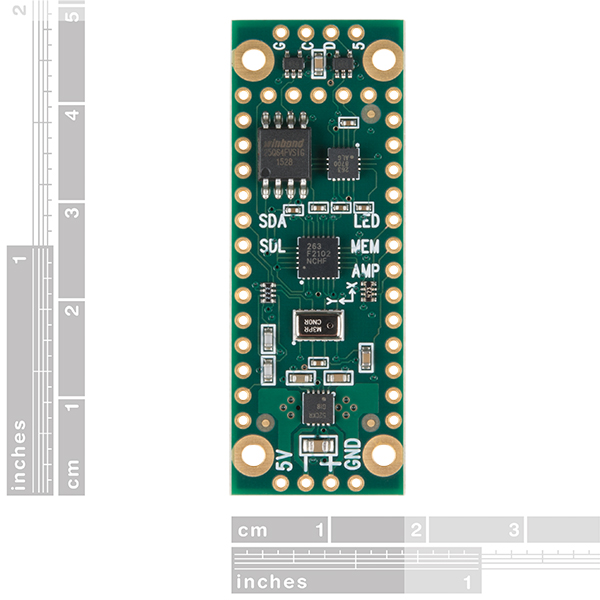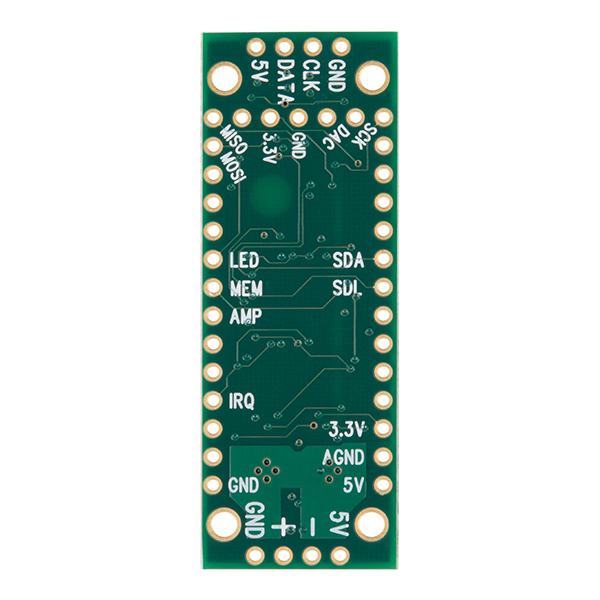Teensy Prop Shield
The Teensy Prop Shield is meant for making interactive light and sound effects on small, handheld props and wearable costumes. This shield features 10DoF (Degrees of Freedom) motion sensors, a 2W audio amp, high-speed 5V buffers for driving APA102 LEDs, and an 8MB flash memory. This little board is about the size of the Teensy 3.2, just slightly longer to allow space for mounting holes and connections for power, speaker and LEDs.
The Teensy Prop Shield's crowning glory is, of course, its Freescale 10DoF sensors. The board's sensor suite comprises an FXOS8700CQ 6-axis linear accelerometer and magnetometer, an FXAS21002C 3-axis digital angular rate gyroscope and an MPL3115A2 precision pressure/altitude and temperature gauge.
That's not all! The Teensy Prop Shield has been equipped with a slew of other features. Need an amplifier? The Teensy Prop Shield has one rated at 2W and is capable of driving 4 or 8 Ohm speakers. Additionally, the Prop Shield has 5V buffers meant to send data to Dotstar or APA102 type addressable LEDs. It also has an onboard 8MB flash memory, meant for storing sound clips and images, logging data and many other uses.
Note: If you are looking for a more economical board than this version of the Prop Shield, be sure to check out the low-cost (LC) version instead!
- Motion Sensors -- Allow motion interactive light and sound
- Audio Amplifier -- Clear quality audio output to a small speaker
- Fast LED Driver -- Drive APA102 / Dotstar LEDs for colorful lighting with rapid response
- Flash Memory -- 8MB storage for images, sound clips and data logging
Teensy Prop Shield Product Help and Resources
Vox Imperium: Stormtrooper Voice Changer
October 25, 2016
Add some flair to your Imperial uniform by changing your voice using a Teensy 3.2 and Prop Shield.
TeensyView Hookup Guide
March 16, 2017
A guide to using the TeensyView OLED board to display text and graphics.
Core Skill: Soldering
This skill defines how difficult the soldering is on a particular product. It might be a couple simple solder joints, or require special reflow tools.
Skill Level: Noob - Some basic soldering is required, but it is limited to a just a few pins, basic through-hole soldering, and couple (if any) polarized components. A basic soldering iron is all you should need.
See all skill levels
Core Skill: Programming
If a board needs code or communicates somehow, you're going to need to know how to program or interface with it. The programming skill is all about communication and code.
Skill Level: Competent - The toolchain for programming is a bit more complex and will examples may not be explicitly provided for you. You will be required to have a fundamental knowledge of programming and be required to provide your own code. You may need to modify existing libraries or code to work with your specific hardware. Sensor and hardware interfaces will be SPI or I2C.
See all skill levels
Core Skill: Electrical Prototyping
If it requires power, you need to know how much, what all the pins do, and how to hook it up. You may need to reference datasheets, schematics, and know the ins and outs of electronics.
Skill Level: Rookie - You may be required to know a bit more about the component, such as orientation, or how to hook it up, in addition to power requirements. You will need to understand polarized components.
See all skill levels
Comments
Looking for answers to technical questions?
We welcome your comments and suggestions below. However, if you are looking for solutions to technical questions please see our Technical Assistance page.
Customer Reviews
5 out of 5
Based on 1 ratings:
1 of 1 found this helpful:
Love it
Very reasonable price, small footprint and works well with demo software. Nice and smooth movement with NXPMotionSense library Here is a 30 second video of it working with the orientation visualization software. Video And with 3d rocket skin: Video





I wanted to jump in and say that this is one of the best, most thoughtfully designed boards I've touched in years. Not only is the 10DoF absurdly accurate, BUT:
I was able to calibrate it while it was 2" from the large surface transducer you sell. I did put a 1/16th sheet of steel in between, and the calibration was not perfect, but it was more than good enough for non-precision gesture detection (such as swinging it back and forth and it knowing which direction it was going)
The little amplifier on the board is not only capable of driving your large surface transducer to the point of distortion (easily fixed by changing the mixer levels), but is also capable of driving this (comparative) monster: Dayton Audio TT25-8 PUCK Tactile Transducer Mini Bass Shaker 8 Ohm. It might not have been couch shaking volume levels, but when lightly set on an air tight cardboard box, the bass was nearly uncomfortable from a couple feet away.
In my design, I'm driving a transducer while monitoring pitch and yaw, driving 20 APA102 leds, driving a single 8W LED with PWM (through a dedicated CC LED driver), accepting input from a hall effect sensor that's on a 39" leash (mounted in the same installation, but far away), triggering a 5V solenoid through a mosfet, and playing MP3 and WAV files, one of which is "It's getting too damn hot" after the MPL3115A2 reports a temperature higher than 112F.
If I had a wild dream version of this board, it would include the audio chip from Paul's Audio shield so that I could maintain the LED updates while some of the more heavy audio processes are running without dropping frames. I don't KNOW if there's a pin compatibility issue with the Audio shield and this, but I'm willing to bet there is. In any case, this is a freakishly useful board, and I now have five of the LC versions mostly for the amplifier and flash for audio projects. I highly recommend these boards.
Wait: this has 10 degrees of freedom and one of them is pressure/altitude and temperature? Is there a reason you count that as 10 and not 11?
From a navigation perspective, your current position does not depend on temperature, so that is not a degree of freedom. The MEMS sensors are affected by temperature, so knowing the temperature the sensors are at may allow one to partially compensate for the errors that are introduced when operating the sensors over a range of temperatures.
It looks like PJRC (the manufacture) lists it as a 10DOF, but it is probably because they are all on the same chip and how they are related. Altitude is derived from pressure and basically just a different way to express the same data. The sensor also reads temperature since that is required for accurate readings and is nice enough to share that data. While there is extra data that could probably justify calling it an 11DOF, at that point it is also just adding numbers because you can without adding functionality.
Great small board, and I like the software that has been written for it. Using a few parts from Sparkfun, I am building a rocket transceiver that will transmit altitude and attitude to a ground station. See my hackaday site